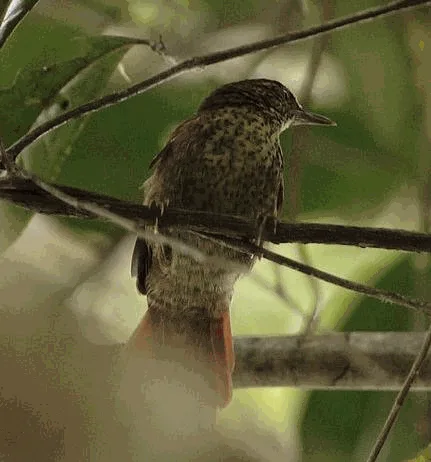
Speckled Spinetail
[order] Passeriformes | [family] Furnariidae | [latin] Cranioleuca gutturata | [UK] Speckled Spinetail | [FR] Synallaxe ponctue | [DE] Fleckenbrust-Baumschlupfer | [ES] Curutie Jaspeado | [IT] Codaspinosa macchiettato | [NL] Gespikkelde Stekelstaart
Subspecies
Monotypic species
Physical charateristics
Forehead buffy; crown, wing coverts and tail rufous-chestnut. Primaries and secondaries brownish black with inner margins buff. rest of upperparts greyish olive brown. Small white eyebrow along side of of head. Chin and upper throat pale yellow, underparts cream color with light black spots all over.
Listen to the sound of Speckled Spinetail
[audio:http://www.aviflevoland.nl/sounddb/S/Speckled Spinetail.mp3]
Copyright remark: Most sounds derived from xeno-canto
| wingspan min.: | 0 | cm | wingspan max.: | 0 | cm |
| size min.: | 13 | cm | size max.: | 15 | cm |
| incubation min.: | 0 | days | incubation max.: | 0 | days |
| fledging min.: | 0 | days | fledging max.: | 0 | days |
| broods: | 0 | eggs min.: | 0 | ||
| eggs max.: | 0 |
Range
Found in Bolivia, Brazil, Colombia, Ecuador, French Guiana, Peru, Suriname, and Venezuela. Very rarely seen in Suriname, only two observations.
Habitat
Flooded evergreen forest and lowland tropical forest, often near shallow streams or water surface.
Reproduction
Presumed monogamous; nest is a cone shaped mass of twigs, hanging from a branch 25 cm long. No further data.
Feeding habits
Diet consists for the greater part of cockroaches and heteroptera (shielded bugs). Found foraging in pairs in midlevel strata, gleaning an probing. Seems to be a dead leafs specialist.
Conservation
This species has a large range, with an estimated global extent of occurrence of 4,200,000 km2. The global population size has not been quantified, but it is believed to be large as the species is described as ‘frequent’ in at least parts of its range (Stotz et al. 1996). Global population trends have not been quantified, but the species is not believed to approach the thresholds for the population decline criterion of the IUCN Red List (i.e., declining more than 30% in ten years or three generations). For these reasons, the species is evaluated as Least Concern.

Migration
Sedentary throughout range.
Distribution map

]]>
